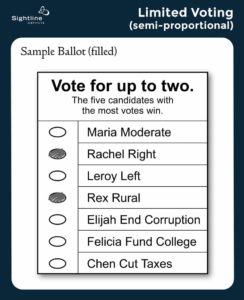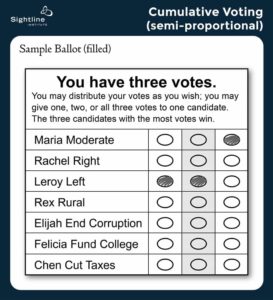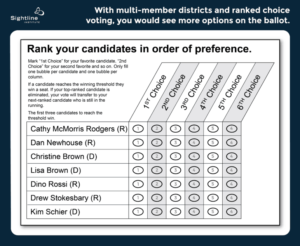Fair Voting Methods for Multi-Seat Elections:
Limited Voting, Cumulative Voting, proportional Ranked Choice Voting
Limited Voting, Cumulative Voting, and the proportional form of Ranked Choice Voting are the three main voting methods used as a “fair vote” alternative to the winner-take-all, plurality voting method used in At-Large elections. These include city councils, school committees, county boards, or any race where the same voters elect more than one person to the same office at once. The winner-take-all voting method for At-Large elections is prone to produce biased results on allowing a single voting block to dominate all the seats. It’s often the subject of legal action under the Voting Rights Act. Fair vote methods give all voters an equal opportunity to gain some measure of representation.
**********
LIMITED VOTING
Limited Voting, as its name suggests, limits voters to casting a number of votes fewer than the number of seats available. This makes it harder for one voting block to sweep all the seats. It gives other voters a better chance to gain at least one seat.
 HOW IT WORKS
HOW IT WORKS
For example in a race with five seats at stake, voters might be limited to two votes, which they may cast one each for the candidates of their choice.
HOW VOTES ARE COUNTED
Votes are counted just like winner-take-all plurality voting. Votes are tallied. The top vote getters win but there is less likelihood that one voting block can control all the results.
WHERE IT’S USED
- Connecticut City Councils.
- Pennsylvania County Government and Philadelphia City Council.
- Local jurisdictions in North Carolina and Alabama.
ADVANTAGES
- It’s easy to use. This voting method is the same as standard plurality voting. Voters mark one vote for each candidate they support.
- There is no initial cost to upgrade voting equipment, as would be needed by the two other fair vote methods.
- It leads to a more representative result depending on the degree of vote-splitting noted below.
DRAWBACKS
- Vote splitting: The votes of like-minded voters can get split between similar candidates—the same as in plurality voting or cumulative voting. This can lead to disproportional results.
- Candidates limited by parties: To address the problem of vote splitting, political parties or interests will meet ahead of time to limit those who are running to the number of seats the political parties or interests perceive those candidates can win. While parties should have some role, this creates two problems: Parties meet behind closed doors to decide who gets to run and thereby voters get less choice. Secondly, by limiting who they nominate, parties also risk underestimating voter support and missing an opportunity to gain an additional seat.
- Limited votes: Voters used to having as many votes as there are seats don’t like the idea of having a reduced number of votes.
Quick reference:
Limited Voting, Wikipedia
*********
CUMULATIVE VOTING
Like standard At-Large voting, cumulative voting gives voters the same number of votes as there are seats on the governing body up for election. But with a crucial difference: Voters are free to use their votes however they want.
 HOW IT WORKS
HOW IT WORKS
For example, in a race with six seats, voters get six votes. But instead of being required to divide their votes up among different candidates, they can give them all to one candidate or split them up however they choose.
HOW VOTES ARE COUNTED
Voters are counted using the same method as standard winner-take-all plurality voting: Votes are tallied and the top vote-getters win. The difference is in the result. There is less likelihood that one voting block can control all the results and more opportunity for others to have their votes and voices heard.
WHERE IT’S USED
- More than one hundred school boards in Texas and South Dakota, among other states, and in some city councils often as a result of voting rights challenges.
- Corporate boards and shareholder votes.
- Board and organizational retreats where participants are asked to choose top choices among a list of goals, strategic directions, etc., which allows participants to assign more of their votes to their strongest preferences.
ADVANTAGES
- It’s easy to use.
- It allows voters to aggregate their votes behind their top choice(s) —rather than being required to divide them one each among candidates.
- On corporate boards, it lets minority shareholders gain some representation on the board of directors of the corporation so they at least can have some say in the management of the company.
DRAWBACKS
- Strategic voting questions: For many voters, it’s challenging to divide one’s own votes strategically, especially in races with many seats at stake among a long list of candidates.
- Vote splitting: Vote splitting can be an issue depending on how voters divide their votes among similar candidates.
- Parties limit candidates: As with limited voting, to avoid vote splitting, parties or interest groups need to limit who runs to the number of expected winnable seats, as a result giving these parties or interest groups more power and voters less choice.
- Cost of running: All candidates still must run At-Large (jurisdiction-wide) and bear the cost of campaigning, raising money, and contacting voters across a large city or county.
The drawbacks are magnified in larger jurisdictions and more seats at stake.
Quick reference:
Cumulative Voting Video, Fair Vote
Cumulative Voting Explained ,Wikipedia
Cumulative Voting: Fast Answers, SEC- U.S. Securities and Exchange Commission
**********
RANKED CHOICE VOTING IN MULTI-WINNER ELECTIONS
Also known as preference voting or the single transferrable vote.
Ranked Choice voting allows voters to rank their choices in order (such as 1, 2, 3, etc.) to show not only a preference for a single top choice but a second or third choice as well.
Ranked Choice Voting is most commonly used in elections with one winner like governor, mayor, or a legislature where there is a single winner. There, it serves to ensure a consensus winner with majority support, allows more parties to compete without being a spoiler, and reduces negative campaigning inherent to zero-sum winner-take-all-elections.
Ranked Choice Voting is also used as a proportional voting method for multi-seat elections, as discussed here, to achieve a more representative result.
 HOW IT WORKS—AS A PROPORTIONAL VOTING METHOD IN MULTI-WINNER ELECTIONS
HOW IT WORKS—AS A PROPORTIONAL VOTING METHOD IN MULTI-WINNER ELECTIONS
Voters rank their choices—1, 2, 3, etc. They can rank as many or as few as they want.
Candidates win when their vote count equals or exceeds the winning threshold or quota. The winning threshold is the number of votes cast divided by the number of seats at stake plus one.
For Example:
If 10,000 ballots are cast and nine seats are at stake, the winning threshold or quota is 1,000 votes.
Number of ballots cast (10,000) / Number of seats + 1 (10)
HOW VOTES ARE COUNTED
There are different ways to count votes. The following is the method used in Cambridge, Massachusetts:
- Step one: Each candidate’s number one (#1) votes are totaled. Candidates are declared winners if the total #1 votes meets or exceeds quota.
- Step two: The “surplus votes” of candidates who received more votes than needed to achieve quota are transferred to a second choice. For example, if a candidate has 100 votes more than quota, then 100 of their ballots are randomly chosen and those ballots go to the second choice.
- Step three: Next the larger voter transfer and count occurs. The candidate in last place with the fewest #1 votes gets dropped. Their votes are transferred to the next choice on a voter’s ballot. It skips over candidates who have already met the quota and been declared winners. The process continues until all the seats are filled. (See video links at end of the section.
WHERE IT’S USED
It’s used to replace plurality, winner-take-all voting in countries that like the U.S. inherited their voting system from England.
- Ireland Parliament (Chamber of Deputies). The deputies are elected in three – to five-seat districts.
- The Australian Senate. The Senate is elected in six-seat districts.
- Some elections in New Zealand, Northern Ireland, Scotland, India, and Canada.
City elections in Cambridge, Massachusetts. - The Academy Awards nomination process and choice for Best Picture.
ADVANTAGES
- It has the most proportional results of the three fair vote methods.
- It avoids the problem of vote splitting
For voters, it requires less strategy or guessing to avoid splitting the vote among like-minded candidates than in cumulative or limited voting. - Because votes transfer – even surplus votes – each vote is more likely to impact the election of a favorite candidate than other voting methods.
DRAWBACKS in jurisdictions with many seats at stake (more than 5)
For candidates they include-
- High cost: The high cost of running—staff, communications, database management, and media;
- More fund-raising: The burden of fund-raising to run citywide; and
- Voter contact challenge: The need to contact voters and gain name recognition across a large jurisdiction often bigger than a state senate seat or congressional district. It typically forces all candidates to spend disproportionate time in the jurisdiction’s older, higher-income areas that have the highest turnout.
For voters, they include-
- Too many candidates: The challenge of knowing who all the candidates are and making choices in a big field;
- Choosing a #1: Deciding among favorite candidates who to give their #1 vote;
- Fear of the unknown: Getting overwhelmed by ranking choices and this becoming a reason not to vote. The use of a slate prepared by a party or civic group, as in Australia’s senate elections, can mitigate this; and
- Confusing to count: While simple enough to use, it’s more difficult to understand how voters are counted, especially to trust the distribution of surplus votes.
Quick reference
Single Transferable Vote (proportional ranked voting), Wikipedia
How does the Single Transferable Vote system operate? Chaitanya Ramesh, Quora, 2015
Videos
How to Vote in Cambridge MA, YouTube upload
Imaginary Animal Kingdom Election, CGP Gray
**********
CONCLUSION
All three methods are more representative than winner-take-all voting method used in At-Large elections,. They prevent one voting block from controlling the outcome of all the seats and let voters rank or weight they preferences among the large field of candidates At-Large. They create more opportunity for candidates of all backgrounds and neighborhoods who may be otherwise underrepresented under the monopoly math of winner-take-all plurality rules.
Ranked Choice Voting and Cumulative Voting work best. Limited Voting’s main attribute is that it is simple and doesn’t require new voting equipment. Today, however, modern voting equipment can be modified to count either Ranked Choice or Cumulative without undue expense. Ranked Choice Voting is the most effective overall because votes transfer. This method avoids splitting votes among similar candidates and ensures that more votes count toward the election of each voter’s choice.
Fair Vote Methods Compared to Single Winner Districts
Single-winner districts are used in all state and federal legislative elections. They are the most common alternative to electing candidates At-Large. Voters like smaller neighborhood-based districts. They provide easier access to representatives who live nearby. With fewer candidates, it’s easier for voters to assess their choices. For candidates, districts are far less costly in money and time. Candidates have the chance to personally connect with more eligible voters in a more defined area.
Districts have well known representational problems. The district lines can be gerrymandered by incumbents to favor themselves or party interests. Voters get fewer choices, if any choice at all. Districts are inherently less competitive and polarizing due to the zero-sum winner-take-all plurality voting method, which mathematically limits competition to two major parties. (See Duverger’s Law.) Districts could work better with nonpartisan redistricting and if, instead of winner-take-all voting, states adopted Ranked Choice Voting for all single-winner races. Several cities have in Minnesota, California and other states have taken this step and Maine voters passed a ballot measure to do the same for all state and federal offices. Opposition from major party leaders make these changes difficult. Still more voters and reformers are calling for change, including a new study on the lack of political competition in U.S. politics from the Harvard Business School.
Small is better: The size of the jurisdiction matters
As an alternative to At-Large or district elections, Fair Vote proportional systems are more representative and provide voters more choice and competition. But they come with their own drawbacks that get magnified in larger, more populous jurisdictions as the costs of running increase, voter contact challenges grow, and voters are less likely to know all the candidates.
For Smaller Jurisdictions with few seats at stake
Fair Vote methods for multi-winner races are easier to use in mid-sized or smaller jurisdictions with fewer seats. For example, Ireland uses Ranked Choice Voting but breaks down its elections for national legislature into multi-winner regional elections of three to five seats. More school boards use fair vote proportional methods. They are generally smaller jurisdictions with fewer seats at stake. These methods, especially cumulative voting or ranked choice voting, are often used in other settings – from college and student council elections to association elections and any meeting, like a board retreat, where participants are asked to vote for their top three or five priorities from a list of choices.
For Larger Jurisdictions with many seats at stake
A city or county changing from all At-Large elections may be better moving to districts. They could preserve a few At-Large seats to maintain the benefits of a jurisdiction-wide perspective. Here it’s essential to avoid the problems of gerrymandering, frequently uncontested or non-competitive seats, and polarized politics endemic to winter-take-all voting. Districts are popular with voters and candidates alike, but would work longer term if jurisdictions used a nonpartisan method or commission for redistricting. The use of ranked choice voting would facilitate competition and ensure the winner has majority support, and mitigate negative politics associated with winner-take all voting.
Additional Information
- The Strengths and Weaknesses of Three Proportional Voting Methods, David Yee , Electoral Reform Aug 12, 2014
- Other Fair Voting Methods, Fair Vote
- Glossary of Voting Methods, Sightline, 2017




